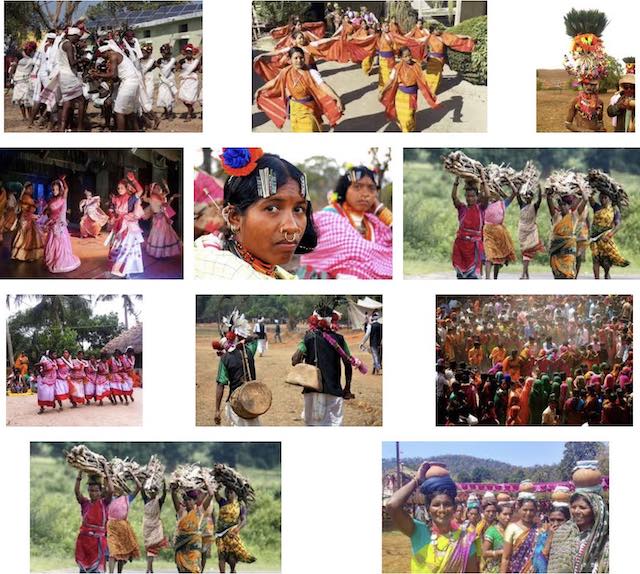at Medaram village © M. Murali | Learn more >>
With the exclusive tribal museum becoming operational on Tuesday, devotees thronging to the historic Medaram village for the Sammakka–Saralakka jatara can now get an insight into the life and culture of Adivasi and Koya tribes. […]
The circular museum building, decorated with murals, has been attracting the devotees to get to know the lifestyle and tools outside of tribal cultures. The visitors take an L shaped walk-through corridor displaying tribal lifestyles, customs and traditions.
Many visitors were observed taking ‘selfies’ and photographs inside and outside the museum. Enthusiastic visitors were also vying to take photographs with life-sized sculptures of traditional Koyas. […]
To showcase the tribal lifestyle, model bamboo machans (cots) have been laid out on the museum grounds. Some photos display the pre-historic stone structures such as dolmens and menhirs that are part of Koya tribal culture.
Source: “Insight into tribal life” by Gollapudi Srinivasa Rao, The Hindu 27 January 2018
https://www.thehindu.com/news/cities/Hyderabad/insight-into-tribal-life/article22531440.ece
Date visited: 10 June 2022
Members of the Koya tribe inhabiting the foothills of the northern Eastern Ghats in Andhra Pradesh are worried. Their lives have been in disarray since India’s nationwide lockdown began on March 24. The government has restricted their movement through the forests, leaving them completely reliant on a few grocery stores in nearby towns, which open only for a few hours every day. Their incomes have also been plummeting, and they are often at the mercy of government agencies, and a few compassionate law-enforcement officials, for their staple foods.[…]
The Koya and Konda Reddi are the two largest tribal groups in the northern Eastern Ghats of Andhra Pradesh. Other tribes include the Nayakpod, Khond, Gadaba, Bagatha, Savara and Paraja. The northern Eastern Ghats is contiguous with the Dandakaranya region in the west, a thickly forested plateau covering the Bastar region of Chhattisgarh and parts of Andhra Pradesh, Telangana and Maharashtra. A large number of the Maria Gond (Gutti Koya in Andhra), displaced from Chhattisgarh over the last two decades due to armed conflict, also inhabit the northern Eastern Ghats.
These communities have lifestyles linked strongly to forests, sustaining themselves primarily through minor forest produce collection, shifting cultivation and seasonal employment in farms. More recently, they have also been forced to seek work in forest plantations and make occasional hunting forays. However, all these livelihood activities have come to an abrupt halt as entry into forests or movement outside villages has been prohibited.
As nations around the world grapple with the health, environmental and economic repercussions of the coronavirus pandemic, we take a bird’s eye view of how the pandemic has affected India’s forest-dwelling tribal communities. […]
This article is part of the National Mission on Biodiversity and Human Well-being (Project No. SA/PM-STAIC/ATREE/Biodiversity/2019 (G)), Principal Scientific Advisor’s Office, New Delhi.
Source: “How the Pandemic Has Affected India’s Forest-Dwelling Communities” by Vikram Aditya postdoctoral research associate) and G. Ravikanth (senior fellow), both at the Ashoka Trust for Research in Ecology and the Environment, Bengaluru.
URL: https://science.thewire.in/politics/rights/how-the-pandemic-has-affected-indias-forest-dwelling-communities/
Date Visited: 10 June 2022
[Bold typeface added above for emphasis]
For how long will I have to
Bear the pain of development
Or is it that I will be done to death
Before attaining development?
Ram Dayal Munda in “The Pain of Development” (Vikas Ka Dard) courtesy Dr. Ivy Hansdak >>
How tribal communities have protected India’s forests and preserved biodiversity all over the world
“Tribal communities have proven that they are the best guardians of the forest and die-hard conservationists”: Illegal mining destroys the life and culture of the conservators of forests >>
“Even though they are responsible for protecting the largest part of the global forest heritage […] a third of indigenous and community lands in 64 countries are under threat due to the lack of land tenure rights.” – Pressenza Rio de Janerio in “Indigenous people are heading to CoP26: ‘There is no solution to the climate crisis, without us’” (Down To Earth, 1 November 2021) >>
“The British established mode of forest governance imposed restrictions on local forest-dwelling communities. In 1860, the Company withdrew all access rights for using the forests (food, fuel, medicine and selling forest products) since the forests and forest-dwelling communities provided refuge to the rebels during the Sepoy Mutiny.” – Bharat Rural Livelihoods Foundation >>
“Tribal population was spread all over India and most of them occupied wild tracts, hilly and forested areas, away from more civilized centers. In 1880 their population was estimated at about seventy million. They had existed for centuries with their own social traditions and beliefs and subsisted on natural resources. They had preserved their near isolation and way of life until the British administration and policies made inroads into their territories.” – Subha Johari in Tribal Dissatisfaction Under Colonial Economy of 19th Century >>

“Two main streams within Indian anthropology influenced the literary and visual representations of tribes by mainstream writers, artists and film-makers.” – Dr. Ivy Hansdak clarifies how they are associated with “assimilationist” and “isolationist” positions or policies >>
In Marginalised but not Defeated, Tarun Kanti Bose (a seasoned public interest journalist) “documents the hard and difficult struggle to implement the Forest Rights Act, how the oppressed adivasis have united into forest unions, how they are now entering into new thresholds of protracted struggles and victories in a non-violent manner.” | Learn more: https://countercurrents.org/2023/05/book-review-marginalised-but-not-defeated >>
“Tribal men and women mix freely, but with respect for each other [but] caste Hindu society in India is so convinced of its own superiority that it never stops to consider the nature of social organisation among tribal people. In fact it is one of the signs of the ‘educated’ barbarian of today that he cannot appreciate the qualities of people in any way different from himself – in looks or clothes, customs or rituals.” – Guest Column in India Today >>
Learn more about colonial policies, the Forest Rights Act, its importance for ecology, biodiversity, ethnobotany and nutrition, and about the usage of Adivasi (Adibasi) communities in different states of India: in legal and historical records, in textbooks, scholarly papers and the media >>
Up-to-date reports by Indian experts and journalists
Search tips
Combine the name of any particular state, language or region with that of any tribal (Adivasi) community.
Add keywords of special interest (music, poetry, dance just as health, sacred grove and biodiversity); learn about the rights of Scheduled Tribes such as the “Forest Rights Act” (FRA); and the United Nations “Declaration on the Rights of Indigenous Peoples”, “Universal Declaration of Human Rights”, “women’s rights”, or “children’s right to education”.
Specify any other issue or news item you want to learn more about (biodiversity, bonded labour and human trafficking, climate change, ecology, economic development, ethnobotany, ethnomedicine, global warming, hunter-gatherers in a particular region or state, prevention of rural poverty, water access).
For official figures include “scheduled tribe ST” along with a union state or region: e.g. “Chhattisgarh ST community”, “Himalayan tribe”, “Scheduled tribe Tamil Nadu census”, “ST Kerala census”, “Particularly Vulnerable Tribal Group Jharkhand”, “PVTG Rajasthan”, “Adivasi ST Kerala”, “Adibasi ST West Bengal” etc.
In case the Google Custom Search window is not displayed here try the following: (1) toggle between “Reader” and regular viewing; (2) in your browser’s Security settings select “Enable JavaScript” | More tips >>
Note: hyperlinks and quotes are meant for fact-checking and information purposes only | Disclaimer >>
List of websites covered by this Google custom search engine
Academia.edu (platform for academics to share research papers) – www.academia.edu
Archive.org – https://archive.org
Centre for Science and Environment – https://www.cseindia.org
Current Conservation – https://www.currentconservation.org
Development and Cooperation (D+C) https://www.dandc.eu
Down To Earth (India) – www.downtoearth.org.in
India Environment Portal – www.indiaenvironmentportal.org.in
Harnessing Nature Magazine – https://harnessingnature.online
Mongabay-India – https://india.mongabay.com
M S Swaminathan Research Foundation – www.mssrf.org
Navdanya (protecting India’s biodiversity based food heritage) – https://navdanya.org
Third World Network (Penang, Malaysia) – https://twn.my
The Shola Trust (nature conservation in the Nilgiri region) – www.thesholatrust.org

Indian online periodicals and platforms | Images view >>
~ ~ ~
Personalize your CustomSearch by combining other search words >>
(e.g. name of a tribal community and region, a craft, or dance and puppetry)
Research the above issues with the help of Shodhganga: A reservoir of theses from universities all over India, made available under Open Access >>
Note: hyperlinks and quotes are meant for fact-checking and information purposes only | Disclaimer >>
See also
eBook | Background guide for education
Forest Rights Act (FRA) | Nishad (Nishada, Sanskrit Niṣāda, “tribal, hunter, mountaineer, degraded person outcast”) | Vanavasi (Vanvasi, Vanyajati)
Forest dwellers in early India – myths and ecology in historical perspective
Scheduled Tribes | Classifications in different states
Women | Safe search | President Droupadi Murmu on women’s empowerment
Tips for using interactive maps
Toggle to normal view (from reader view) should the interactive map not be displayed by your tablet, smartphone or pc browser
For details and hyperlinks click on the rectangular button (left on the map’s header)
Scroll and click on one of the markers for information of special interest
Explore India’s tribal cultural heritage with the help of another interactive map >>